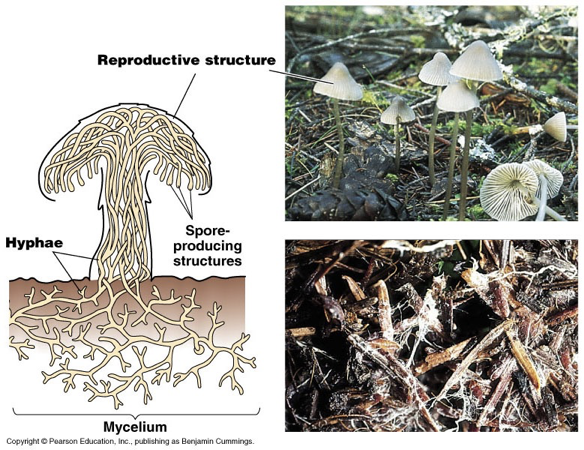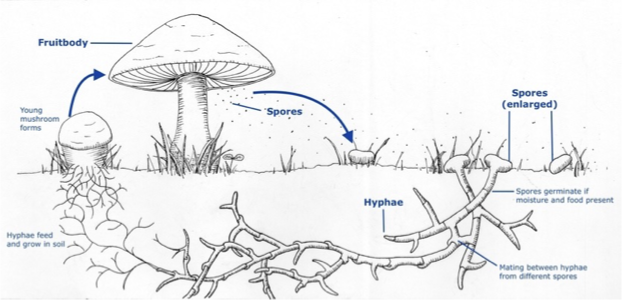kingdom fungi 11
1/15
There's no tags or description
Looks like no tags are added yet.
Name | Mastery | Learn | Test | Matching | Spaced |
|---|
No study sessions yet.
16 Terms
Main Characteristics of Fungi
Although often mistaken for plants, fungi are unique from both plants and animals
Mostly Multicellular except unicellular yeast
NO photosynthesis: heterotrophic
Mostly terrestrial- there are some marine fungi
Mostly decomposers (recycle nutrients)
Cell wall made from chitin (a complex carbohydrate)
reproduce sexually and asexually using spores
Lack true roots, stems and leaves
Some are edible while others are poisonous
General Structure of Fungi
Fungi are filamentous structures.
Composed of filaments called HYPHAE (elongated cells with nuclei that form a branching filamentous structure)
Many hyphae are divided into individual cells by cell walls called SEPTA.

Mycelium
multiple hyphae forming a branching network of filaments is called a MYCELIUM (typically the part growing underground. Not always)
Reproductive Structure
The fruiting body is the part of a fungi that will house the reproductive structures (spores)

How do Fungi obtain Nutrients?
Fungi digest their food OUTSIDE their body – extracellular digestion
Fungi grow beside or on their food source
They excrete digestive enzymes into the surrounding environment
These enzymes breakdown their food into simpler molecules that can be absorbed into the hyphae
Known as saprobic (referring to dead matter) heterotrophs
REPRODUCTION of fungi
Most fungi reproduce Asexually and Sexually by spores
ASEXUAL reproduction is most common method & produces genetically identical organisms
Fungi reproduce SEXUALLY when conditions are poor & nutrients scarce. This creates genetically diverse offspring.
Spores (fungi)
Spores are an adaptation to life on land
Ensure that the species will disperse to new locations
Each spore contains a reproductive cell that forms a new organism
Nonmotile on their own
what are spores made out of
Spores are made of:
Dehydrated cytoplasm
Protective coat
Haploid cell – single set of chromosomes (amount of DNA)
Wind, animals, water, & insects spread spores
Spores germinate when they land on a moist surface (new hyphae form)
Three types of Asexual Reproduction
Fragmentation – part of the mycelium becomes separated & begins a life of its own
Budding – a small cell forms & gets pinched off as it grows to full size
Used by yeasts
Asexual spores – production of spores by a single mycelium
Classification by Nutrition - fungi
Saprobes
-Decomposers
-Molds, mushrooms, etc.
Parasites
-Harm host
-Rusts and smuts (attack plants)
Mutualists
-Both benefit
-Lichens
-Mycorrhizas
Phylum: Ascomycota
Key Features:
sexual spores formed in sac-like “ascus”
Important to humans for fermentation, and food
Very diverse phylum
characteristics:
Called Sac fungi
Includes Cup fungi, morels, truffles, yeasts, and mildew
May be plant parasites (Dutch elm disease and Chestnut blight)
Reproduce sexually & asexually
Ascus - sac that makes ascospores in sexual reproduction
Uses
Truffles and morels are edible ascomycetes
Penicillium mold makes the antibiotic penicillin.
Some ascomycetes also gives flavor to certain cheeses.
Saccharomyces cerevesiae (yeast) is used to make bread rise and to ferment beer & wine.
Phylum: Basidiomycota
Key Features:
Commonly called CLUB fungus
Produce “mushroom-cap” fruiting bodies
Mostly decomposers
characteristics: Called Club fungi
Includes:
Mushrooms
Toadstools
Bracket & Shelf fungi
Puffballs
Stinkhorns
Rusts and smuts
uses: Some are used as food (mushrooms)
Others damage crops (rusts & smuts)
Phylum: Zygomycota
Key Features:
Mostly soil fungi
Includes bread and fruit molds (powdery molds)
Decompose soil, plant matter and dung
Most commonly forms “molds”
Phylum: Chytridiomycota
Key Features:
Mostly decomposers – biodegrade and recycle nutrients
Some have “swimming spores”
zoospores (motile cells) with a single, posterior, whiplash structure (flagellum)
Ex. Allomyces – a water mold
Phylum: Glomeromycota
Key Features
All form symbiotic relationships with plant roots
Form spores.
Are all mutualistic with plants
Can for relationships with plants and bacteria.
Grow on plant roots and actual help plants to obtain nutrients such as phosphorus
Symbiotic Relationships in Fungi
Fungi receives sugar from the roots and in return sends nutrients and water to plant
Lichen
Partnership between fungus and cyanobacteria, or green algae
Fungus provides structure, can digest / absorb nutrients and water and can protect from harsh conditions
Cyanobacteria or algae produce sugar (food)
Mycorrhizae
Partnership between fungus and plant roots
Fungus provides increased capacity for absorption of nutrients and water
Plant produces sugar (food)